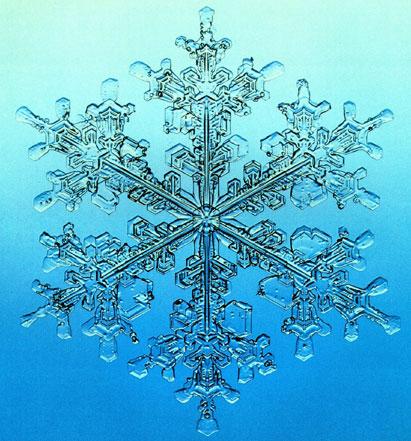Snowflake
2001/02/04 Mendiburu, Joana - Elhuyar Zientziaren Komunikazioa
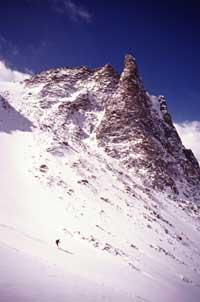
This year's winter will undoubtedly be remembered as a windy winter and not as a cold winter. But well, if we don't talk about snow now, when will we? In this way, we will also show that it is interesting to talk about the weather and if you find the neighbor in the elevator, instead of saying the usual, you can show that you know a lot about snowflakes. In fact, some studies have shown that it is impossible to find two equal snowflakes, which is one of the consequences of special conditions for snowflakes.
But how do snowflakes arise?
Snow certainly requires a low temperature, but it is not the only condition. And because, like that cold temperature, it is necessary that the atmosphere has enough moisture to produce snowflakes and that there are very small particles in the air. For example, the presence of particles such as smoke, dust or sand is mandatory.
In high clouds, in the presence of cold, the amount of water in the air condenses in the form of ice crystals around small particles. As ice crystals gain the necessary weight, they head to the ground. In this way air layers run at different temperatures and to be able to reach the ground it is evident that, in order not to melt on the road, the air layers that cross must be below 0 degrees. As they fall into a warmer atmosphere, microscopic ice crystals come together forming snowflakes.
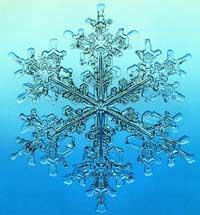
But, for example, it is enough not to meet one of these three conditions in order not to snow. As is normal, if the temperature is too high, the humidity instead of turning into ice becomes a drop of small water, thus raining. But, like too high temperature, too low temperature does not produce snow. That is why it is sometimes said that there is too cold to snow. In fact, as it ascends the earth's surface, the air cools and thus loses moisture. Normally, if about 0º C, the ice crystals come together, but when the temperature cools too much, due to the lack of humidity, it is increasingly difficult to put them together. Thus, when -20ºC is almost impossible to snow.
Snowflakes in search of twins
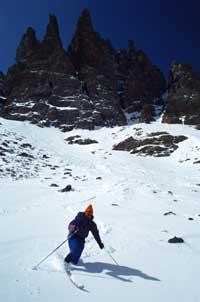
It was already known that snowflakes are rare, that is, that there are no two snowflakes equal. And of course, as the human being needs to know everything, several researchers have wanted to know the reason for this event. Ukichiro Nakaya was the first scientist to study why there are no twin snowflakes. In 1936, while the laboratory of the University of Hokkaido investigated snowflakes, he observed that slightly changing the air temperature changed the shape of the ice crystal. Despite its short life, the snowflake, on its way to the ground, crosses areas of different temperature, which conditions its final appearance. There are snowflakes with different shapes of flowers, ferns, perforated needles, drills, etc.
But it is not the only study that has been done. At the California Institute of Technology, physicist Ken Libbrecht wanted to determine how and why these changes occur. In the cold rooms that guaranteed adequate conditions for snowflakes, Ken Libbrecht launched water molecules to study the formation of ice crystals. He says that the snowflake embryo is a hexagonal prism formed by a water molecule that clumps around a small particle of dust. All snowflakes have the same base. According to scientists, the main reason that each snowflake has a special shape is the almost liquid layer that forms on the surface of the ice crystal.
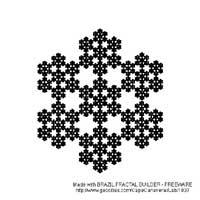
To create this layer you have to consider two factors. On the one hand, the surface of the glass itself and on the other, the temperature. In fact, the almost liquid layer forms at one temperature or another depending on the surface of the glass. Knowing these complex conditions is better understood why it is impossible to find twin snowflakes. On the other hand, it should be noted that snowflakes with almost liquid layer increase much faster, since this layer gives the snowflake the necessary moisture.
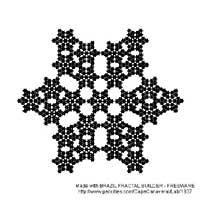
But research somewhere is not over. It has also sought to identify how snowflake grows according to temperature. It seems that if the snowflake passes through a cold temperature, the arms lengthen. If the temperature warms up, instead of stretching the arms, they get fat. In total, snowflakes can be classified into five groups that are indicators of the temperature existing at the time of snow formation. This beautiful research does not think that then it will not work for anything. In fact, the analysis of snow aims to identify the temperature existing at different altitudes and different layers of atmospheric air.
It has become clear, at least, that to create two equal snowflakes, two equal prisms would have to cross the same micro areas, which can hardly happen. Rarely is the word forbidden in science!
Published in 7K

Gai honi buruzko eduki gehiago
Elhuyarrek garatutako teknologia




